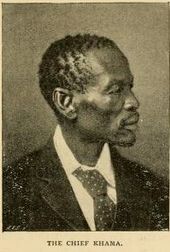Bamangwato
The Bamangwato (also Mangwato or BagammaNgwato ) are an ethnic group in Botswana . Your totem is the phuthi or duiker . They belong to the Batswana and speak Setswana or its dialect Sengwato. Most of Bamangwato live in the Central District .
history
The Bamangwato split from the Bakwena around 1780 . Their ruler ( kgamakgolo ) Malope had three sons, including Ngwato, who formed three groups. Ngwato and his followers moved northwards and formed their own ethnic group that ruled over other groups such as the numerically superior Bakalanga and Basarwa . Traditionally, your capital changed several times. So were Shoshong and Phalatswe (Old Palapye ) at the official residences before 1902 Serowe was selected. The Bamangwato were mainly cattle breeders. The Bamangwato moved their cattle up to 250 kilometers from the respective capital.
Important rulers were Sekgoma I († 1875) and Khama III. (around 1837-1923). Khama III. converted to Christianity and achieved recognition of what is now Botswana as the British protectorate of Bechuanaland . So it was protected from the conquest plans of South African rulers, such as Cecil Rhodes . Khama's son Sekgoma II (1869–1925) ruled only briefly. Sekgoma's son Seretse Khama became the first president of Botswana in 1966, Seretse Khama's son Ian Khama held this office from 2008 to 2018. Ian Khama is now nominally ruler of the Bamangwato.
Others
The dialect Sengwato contains a sound that is unique in the world - a hybrid of f and s.
Individual evidence
- ↑ Description at thuto.org , accessed on September 5, 2016
- ↑ a b Michael Bollig, Michael Schegg, Hans-Peter Wotzka: Pastoralism in Africa: past, present and future. Berghahn Books, New York City 2013, ISBN 9780857459091 , p. 490. Excerpts from books.google.de
- ↑ Lecture by Elizebeth Zsiga, University of Georgetown (2006), from around 5:00 min (English; video), accessed on October 2, 2015
